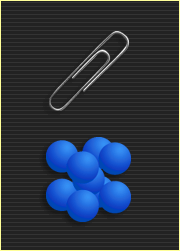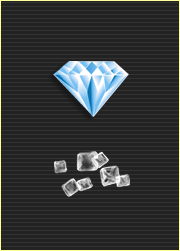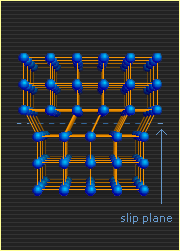The Structure of MetalThe Crystals that Make the Metal
This is the crystalline structure for iron atoms. The atoms of other metals, such as aluminum and zinc, have different arrangements.
In this diagram, each square represents an individual atom. The Bonds that Connect the Crystals
There are three main types of bonds that bind atoms together: the ionic bond, the covalent bond, and the metallic bond. With the ionic bond, positively charged atoms are attracted to negatively charged atoms. Salt, or NaCl, is an example of a crystal held together by ionic bonds. With the covalent bond, atoms share their outermost electrons. The sharing of electrons between the carbon atoms of a diamond is an example. With the metallic bond, atoms are also held together by their outermost electrons, but instead of being shared by a couple of atoms, these electrons act like a cloud that is able to move through the structure of the crystal. This cloud, which is negatively charged (electrons have a negative charge), pulls on the atoms, which are positively charged (each atom is missing one or more of its electrons). The attraction between the atoms extends beyond the crystal, pulling in on adjacent crystals. The electron cloud moves freely when a voltage is applied. This movement of electrons is an electric current. The electron cloud can also transfer thermal energy, making it a good conductor of heat. Also, the electron cloud absorbs then radiates most of the light that falls on it, which gives metal its lustrous appearance. The Flaws that Break the Bonds
Adding other elements to a metal can counteract the effects of the imperfections and make the metal harder and stronger. Carbon, for example, is added to iron to make steel, and tin is added to copper to make bronze. |
|
|
|
|
|
Building on Ground Zero Home | Send Feedback | Image Credits | Support NOVA |
© | Created August 2006 |


 Let's take a look at a paper clip. A typical paper clip is
made up of 1,000,000,000,000,000,000,000 atoms of iron. These
atoms are tightly packed and in a crystalline structure, a
regular arrangement of atoms that repeats itself many times.
Let's take a look at a paper clip. A typical paper clip is
made up of 1,000,000,000,000,000,000,000 atoms of iron. These
atoms are tightly packed and in a crystalline structure, a
regular arrangement of atoms that repeats itself many times.
 The structure of iron atoms isn't continuous throughout the
entire paper clip. When a metal cools and is transitioning
from liquid to solid, its atoms come together to form tiny
grains, or crystals. Even though the crystalline structure
does not continue from crystal to crystal, the crystals are
bound to one another.
The structure of iron atoms isn't continuous throughout the
entire paper clip. When a metal cools and is transitioning
from liquid to solid, its atoms come together to form tiny
grains, or crystals. Even though the crystalline structure
does not continue from crystal to crystal, the crystals are
bound to one another.
 The bond that holds the crystals of a metal together is
actually the same that holds the atoms within each crystal
together: the metallic bond.
The bond that holds the crystals of a metal together is
actually the same that holds the atoms within each crystal
together: the metallic bond.
 When a metal crystal forms, the atoms try to assemble
themselves into a regular pattern. But sometimes there isn't
an atom available to fill in a space, and sometimes a growing
layer is halted by other growing layers. There are many
imperfections within each crystal, and these flaws produce
weak points in the bonds between atoms. It is at these points,
called slip planes, that layers of atoms are prone to move
relative to adjacent layers if an outside force is applied.
When a metal crystal forms, the atoms try to assemble
themselves into a regular pattern. But sometimes there isn't
an atom available to fill in a space, and sometimes a growing
layer is halted by other growing layers. There are many
imperfections within each crystal, and these flaws produce
weak points in the bonds between atoms. It is at these points,
called slip planes, that layers of atoms are prone to move
relative to adjacent layers if an outside force is applied.